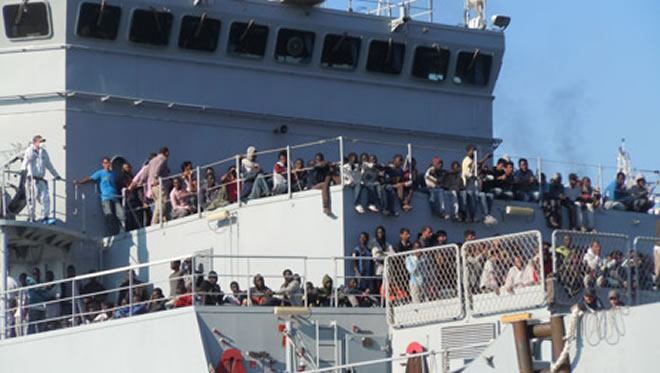
By Andreea Anca, Sr. Communications Officer, EZ
Thursday, July 31, 2014

The Etna vessel pulls in at the Campania harbour with some 2,000 migrants on board, gathered at sea by the Italian navy from smaller overcrowded boats. The ItRC answered to the migrants needs and offered psychosocial support upon arrival. ItRC
In Sicily, dozens of Italian Red Cross (ItRC) vehicles and ambulances as well as volunteers, receive migrants who land on the southern shores of Italy on a daily basis, exhausted and traumatized after a perilous journey at sea.
Earlier this month at the Sicilian port of Augusta, the ItRC volunteers answered the immediate needs of a newly arrived group of 406 migrants coming in from the African continent. Another 100 migrants, who arrived that same day to Sicily in a tanker, were shipped to Genoa, located at the northern part of Italy.
On board of the vessel that transported the migrants up north was a Red Cross cultural mediator who spoke Arabic, French and English, a psychologist, and a French and English speaking volunteer, who gave first aid to those in need.
In Genoa, the Liguria branch of the ItRC summoned doctors, nurses and psychologists to assist the newly arrived, and also assisted the police in carrying out an initial survey of their immediate needs. Volunteers distributed bottles of water and hot meals.
Florence Call for Action
Unfortunately, not all migrants make it to their destination. In a recent tragic incident off the coast of Sicily, 30 corpses were found in the hold of an overcrowded vessel that carried more than 500 people on board. Those who lived to tell the grim details of their journey said that fellow companions died by suffocating in the heat and the fumes of the engine in the overcrowded space.
More disturbing accounts speak of some 100 people who were stabbed and thrown overboard in the panic that broke out during a confrontation between those who wanted to continue their journey and those who could no longer stand the horrendous conditions on the boat and wanted to return to Tunisia.
Although migrants travelling by sea account for the highest number of deaths among smuggled migrants, not all journeys end in tragedy.
The day before this deadly incident, the Etna vessel pulled in at the harbour in Campania with some 2,000 migrants on board who were gathered by the Italian navy from smaller, overcrowded boats in the Mediterranean Sea.
The ItRC was on the shore ready to answer the basic needs of the newly arrived, and offered them much needed psychological support. Around 60 operators and volunteers from the ItRC branch of Salerno were waiting with a temporary shelter set up near the harbour, two medical points, and a gazebo for children.
The 9th European Red Cross Red Crescent Regional Conference in Florence , held between 4-6 June, 2014 built on the migration resolution adopted at the 31st International Conference of the Red Cross and Red Crescent in 2011, and produced the Florence Call for Action, which listed a series of concrete action points , “emphasizing the importance of dignity, respect for diversity, and social inclusion of migrants.”
The adoption of the IFRC Policy on Migration, issued in 2009, clarified the IFRC mandate to address the humanitarian concerns of migrants “living at the margins of conventional health, social and legal systems”, throughout their journey. The document represents a determined call on states to offer humanitarian assistance and access to relevant services to migrants irrespective of their legal status.
As a result, Red Cross National Societies in places such as Italy and Malta - where tens of thousands have arrived by boat in recent years - focus on supporting the authorities to provide all vulnerable migrants with lifesaving humanitarian assistance.
The action of the Red Cross in these countries also includes restoring family links (RFL) with the help of its worldwide network of National Societies and the technical coordination of the ICRC.
For years, the migratory trail from Northern Africa to Italy and Malta through the Mediterranean Sea has been an important entry point for migrants to the EU. Among the 40,000 migrants travelling this route in 2013, the top three nationalities included Syrians, Eritreans and Somali nationals arriving to Italy and Malta from Libya.
The number of people arriving to Italian shores alone increased dramatically this year and reached 63,884 by July.